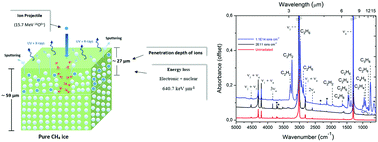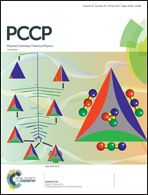Ion irradiation of pure and amorphous CH4 ice relevant for astrophysical environments
Abstract
This work presents a physicochemical study of frozen amorphous methane (at 16 K) under bombardment by medium-mass ions (15.7 MeV 16O5+) with implications for icy bodies in the outer Solar System exposed to the action of cosmic rays and energetic particles. The experiment was performed at the Grand Accélérateur National d'Ions Lourds (GANIL) located in Caen, France. The results demonstrate that irradiation of CH4-containing ices by swift medium mass ions with delivered energy covering both stopping power regimes until its implantation on ice (i.e. electronic and nuclear) leads to the production of many hydrocarbons, such as C2H2, C2H4, C2H6, and C3H8 (the most abundant daughter species produced). Values for the effective dissociation cross section of CH4 and the average value for the effective formation cross-sections of its daughter species were about 10−14 cm2 and 10−15 cm2, respectively. The half-life of methane ice in the presence of swift medium mass ions extrapolated to some outer Solar System environments is estimated to be around 106 years. The measured sputtering yield of methane due to incoming swift ions was about 7.30 × 105 molecules per impact. Such parameters can be used as models to estimate the amount of CH4 and other molecular species desorbed from the icy surfaces that are constantly being incorporated to the gaseous atmosphere in the vicinity of these outer Solar System bodies due to the presence of energetic particles and cosmic rays.



 Please wait while we load your content...
Please wait while we load your content...